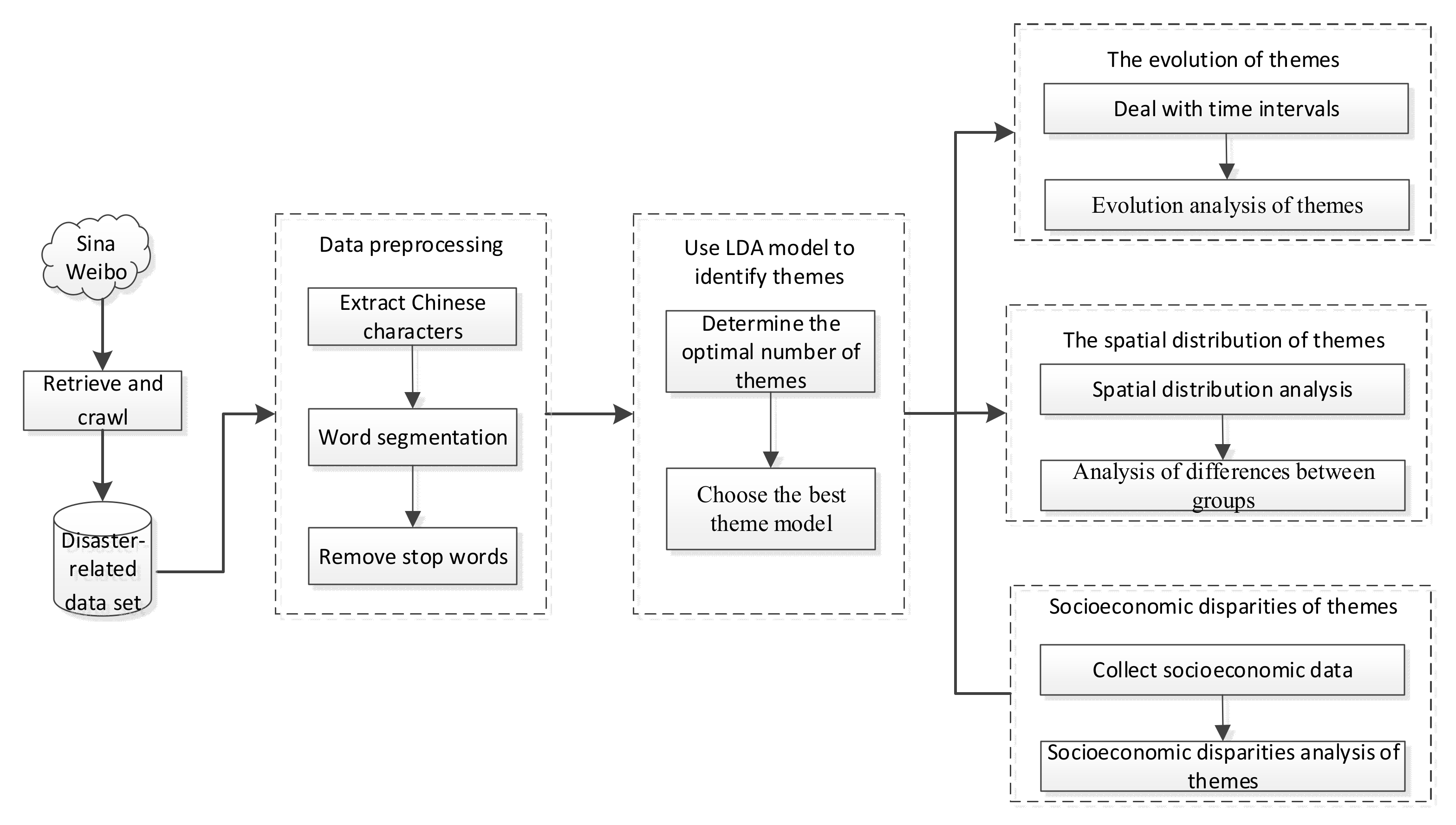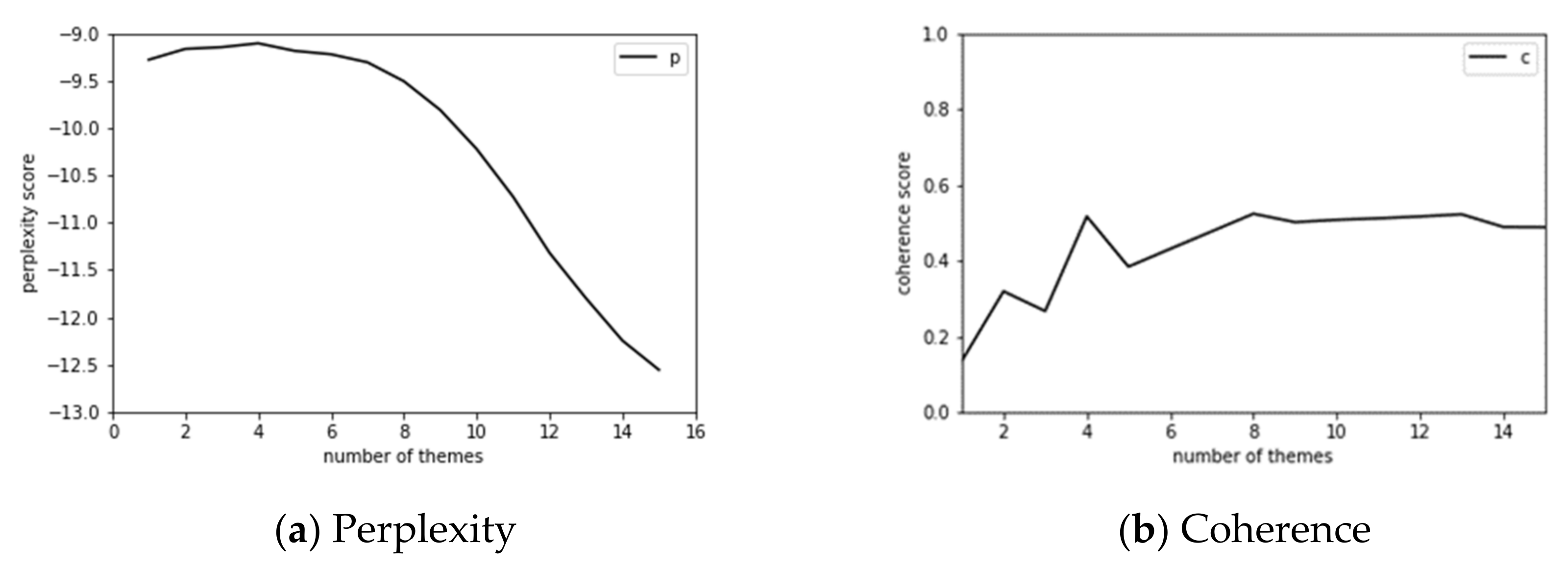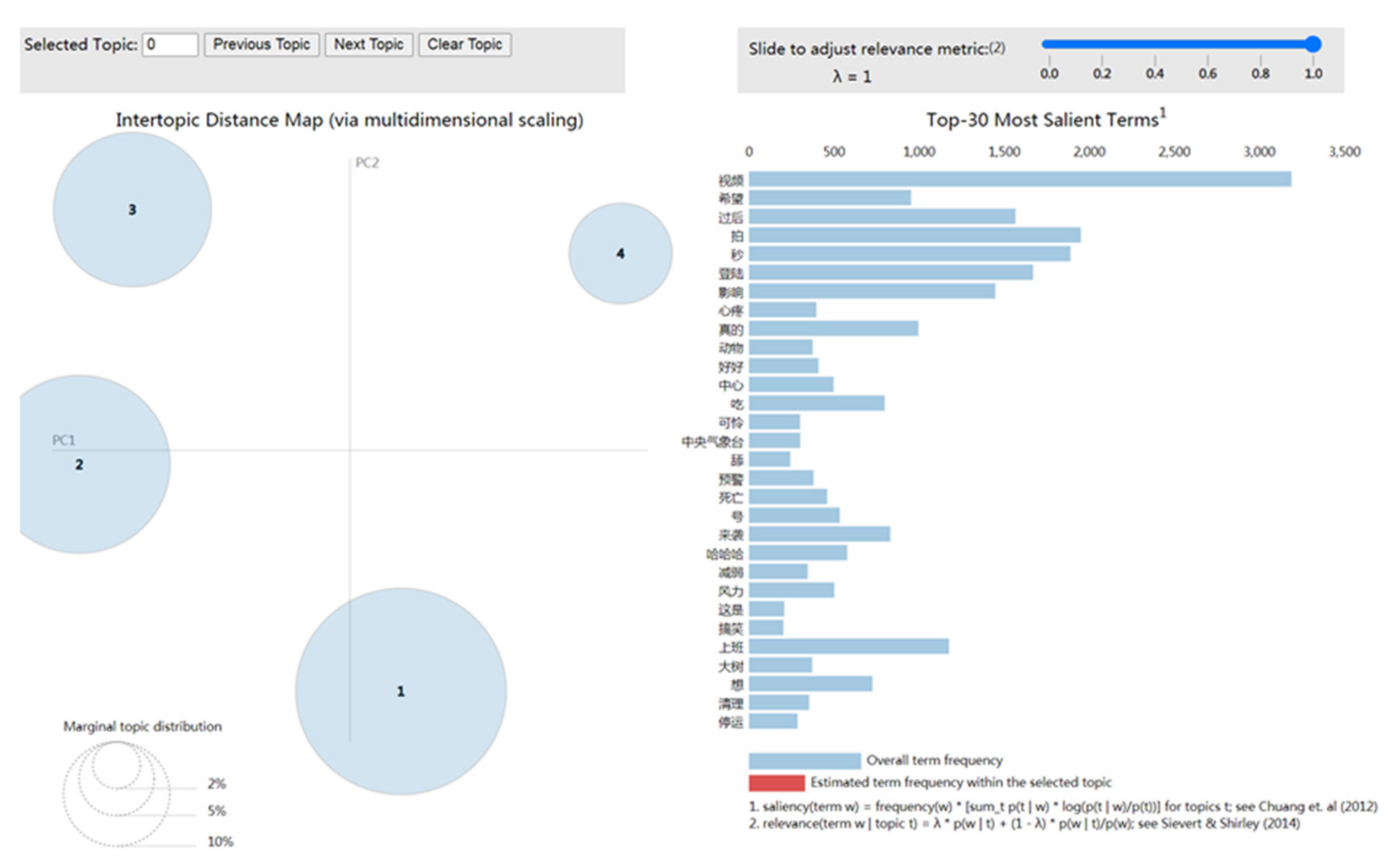Temporal, Spatial, and Socioeconomic Dynamics in Social Media Thematic Emphases during Typhoon Mangkhut
Abstract
:1. Introduction
- RQ1: What major themes appear in Sina Weibo texts during a typhoon disaster?
- RQ2: What is the temporal and spatial distribution of themes?
- RQ3: Are there any differences in thematic emphases across disparate socioeconomic groups?
2. Literature Review
2.1. Content Analysis on Social Media in Disaster Management
2.2. Disparities in Social Media
3. Materials and Methods
3.1. Typhoon Mangkhut as a Case Study
3.2. Sina Weibo Data
3.3. Socioeconomic Data
3.4. Research Design
4. Results
4.1. Major Themes Appear in Sina Weibo Texts
4.2. Analysis on the Evolution of the Themes
4.3. Analysis on the Spatial Distribution of Themes
4.4. Analysis on Socioeconomic Disparities of Thematic Emphases
5. Discussion
5.1. Principal Results
5.2. Limitations and Future Research
6. Conclusions
Author Contributions
Funding
Institutional Review Board Statement
Informed Consent Statement
Data Availability Statement
Conflicts of Interest
Appendix A
| Levene’s Test for Equality of Variances | t-Test for Equality of Means | ||||||
|---|---|---|---|---|---|---|---|
| F | Sig. | t | df | Sig. (Two-Tailed) | 95% Confidence Interval of the Difference | ||
| Lower | Upper | ||||||
| Equal variances assumed | 4.339 | 0.040 | −1.726 | 112 | 0.087 | −0.0716112 | 0.0049264 |
| Equal variances not assumed | −1.802 | 111.780 | 0.074 | −0.0700012 | 0.0033164 | ||
| Levene’s Test for Equality of Variances | t-Test for Equality of Means | ||||||
|---|---|---|---|---|---|---|---|
| F | Sig. | t | df | Sig. (Two-Tailed) | 95% Confidence Interval of the Difference | ||
| Lower | Upper | ||||||
| Equal variances assumed | 27.757 | 0.000 | −6.193 | 79 | 0.000 | −0.1751184 | −0.0899311 |
| Equal variances not assumed | −6.243 | 56.700 | 0.000 | −0.1750352 | −0.0900143 | ||
| Levene’s Test for Equality of Variances | t-Test for Equality of Means | ||||||
|---|---|---|---|---|---|---|---|
| F | Sig. | t | df | Sig. (Two-Tailed) | 95% Confidence Interval of the Difference | ||
| Lower | Upper | ||||||
| Equal variances assumed | 3.516 | 0.066 | −7.962 | 54 | 0.000 | −0.1007307 | −0.0602044 |
| Equal variances not assumed | −7.482 | 35.905 | 0.000 | −0.1022827 | −0.0586524 | ||
References
- Luna, S.; Pennock, M.J. Social media applications and emergency management: A literature review and research agenda. Int. J. Disaster Risk Reduct. 2018, 28, 565–577. [Google Scholar] [CrossRef]
- Zhang, C.; Fan, C.; Yao, W.; Hu, X.; Mostafavi, A. Social media for intelligent public information and warning in disasters: An interdisciplinary review. Int. J. Inf. Manag. 2019, 49, 190–207. [Google Scholar] [CrossRef]
- Rojas, M.M.; Pardo-Ferreira, M.D.C.; Rubio-Romero, J.C. Twitter as a tool for the management and analysis of emergency situations: A systematic literature review. Int. J. Inf. Manag. 2018, 43, 196–208. [Google Scholar] [CrossRef]
- Xu, Z.; Lachlan, K.; Ellis, L.; Rainear, A.M. Understanding public opinion in different disaster stages: A case study of Hurricane Irma. Internet Res. 2019, 30, 695–709. [Google Scholar] [CrossRef]
- Fan, C.; Mostafavi, A.; Gupta, A.; Zhang, C. A system analytics framework for detecting infrastructure-related topics in disasters using social sensing. In Privacy Enhancing Technologies; Springer Science and Business Media LLC: Berlin/Heidelberg, Germany, 2018; pp. 74–91. [Google Scholar]
- Zhao, X.; Zhan, M.; Wong, C.-W. Segmenting and understanding publics in a social media information sharing network: An interactional and dynamic approach. Int. J. Strat. Commun. 2017, 12, 25–45. [Google Scholar] [CrossRef]
- Li, L.; Goodchild, M.F.; Xu, B. Spatial, temporal, and socioeconomic patterns in the use of Twitter and Flickr. Cartogr. Geogr. Inf. Sci. 2013, 40, 61–77. [Google Scholar] [CrossRef]
- Akter, S.; Wamba, S.F. Big data and disaster management: A systematic review and agenda for future research. Ann. Oper. Res. 2017, 283, 939–959. [Google Scholar] [CrossRef] [Green Version]
- Sarker, M.N.I.; Peng, Y.; Yiran, C.; and Shouse, R.C. Disaster resilience through big data: Way to environmental sustainability. Int. J. Disaster Risk Reduct. 2020, 51. [Google Scholar] [CrossRef]
- Liu, Y.; Yuan, Y.; Zhang, F. Mining urban perceptions from social media data. J. Spat. Inf. Sci. 2020, 51–55. [Google Scholar] [CrossRef]
- Pekar, V.; Binner, J.; Najafi, H.; Hale, C.; Schmidt, V. Early detection of heterogeneous disaster events using social media. J. Assoc. Inf. Sci. Technol. 2019, 71, 43–54. [Google Scholar] [CrossRef]
- Perinan-Pascual, C.; Arcas-Tunez, F. The analysis of tweets to detect natural hazards. In Intelligent Environments 2018; Chatzigiannakis, I., Tobe, Y., Novais, P., Amft, O., Eds.; Ios Press: Amsterdam, The Netherlands, 2018. [Google Scholar]
- Li, Z.; Wang, C.; Emrich, C.T.; Guo, D. A novel approach to leveraging social media for rapid flood mapping: A case study of the 2015 South Carolina floods. Cartogr. Geogr. Inf. Sci. 2018, 45, 97–110. [Google Scholar] [CrossRef]
- Son, J.; Lee, H.K.; Jin, S.; Lee, J. Content features of tweets for effective communication during disasters: A media synchronicity theory perspective. Int. J. Inf. Manag. 2019, 45, 56–68. [Google Scholar] [CrossRef]
- Vyncke, B.; Perko, T.; van Gorp, B. Information sources as explanatory variables for the belgian health-related risk perception of the fukushima nuclear accident. Risk Anal. 2016, 37, 570–582. [Google Scholar] [CrossRef] [PubMed] [Green Version]
- Balog-Way, D.; McComas, K.; Besley, J. The evolving field of risk communication. Risk Anal. 2020, 40, 2240–2262. [Google Scholar] [CrossRef] [PubMed]
- Yoo, W. How risk communication via Facebook and Twitter shapes behavioral intentions: The case of fine dust pollution in South Korea. J. Heal. Commun. 2019, 24, 663–673. [Google Scholar] [CrossRef] [PubMed]
- Guidry, J.P.; Jin, Y.; Orr, C.A.; Messner, M.; Meganck, S. Ebola on Instagram and Twitter: How health organizations address the health crisis in their social media engagement. Public Relat. Rev. 2017, 43, 477–486. [Google Scholar] [CrossRef]
- Zhao, Y.X.; Cheng, S.X.; Yu, X.Y.; Xu, H.L. Chinese public’s attention to the covid-19 epidemic on social media: Observational descriptive study. J. Med. Internet Res. 2020, 22. [Google Scholar] [CrossRef]
- Ma, X.; Liu, W.; Zhou, X.; Qin, C.; Chen, Y.; Xiang, Y.; Zhang, X.; Zhao, M. Evolution of online public opinion during meteorological disasters. Environ. Hazards 2019, 19, 375–397. [Google Scholar] [CrossRef]
- Shan, S.; Zhao, F.; Wei, Y.; Liu, M. Disaster management 2.0: A real-time disaster damage assessment model based on mobile social media data—A case study of Weibo (Chinese Twitter). Saf. Sci. 2019, 115, 393–413. [Google Scholar] [CrossRef]
- Wu, D.; Cui, Y. Disaster early warning and damage assessment analysis using social media data and geo-location information. Decis. Support. Syst. 2018, 111, 48–59. [Google Scholar] [CrossRef]
- Yuan, F.X.; Liu, R. Feasibility study of using crowdsourcing to identify critical affected areas for rapid damage as-sessment: Hurricane matthew case study. Int. J. Disaster Risk Reduct. 2018, 28, 758–767. [Google Scholar] [CrossRef]
- Kryvasheyeu, Y.; Chen, H.; Obradovich, N.; Moro, E.; Van Hentenryck, P.; Fowler, J.; Cebrian, M. Rapid assessment of disaster damage using social media activity. Sci. Adv. 2016, 2, e1500779. [Google Scholar] [CrossRef] [Green Version]
- Jamali, M.; Nejat, A.; Ghosh, S.; Jin, F.; Cao, G. Social media data and post-disaster recovery. Int. J. Inf. Manag. 2019, 44, 25–37. [Google Scholar] [CrossRef]
- Wang, Z.; Ye, X. Social media analytics for natural disaster management. Int. J. Geogr. Inf. Sci. 2018, 32, 49–72. [Google Scholar] [CrossRef]
- Sharma, S.; Jain, A. Role of sentiment analysis in social media security and analytics. Wiley Interdiscip. Rev. Data Min. Knowl. Discov. 2020, 10, 27. [Google Scholar] [CrossRef]
- Resch, B.; Usländer, F.; Havas, C. Combining machine-learning topic models and spatiotemporal analysis of social media data for disaster footprint and damage assessment. Cartogr. Geogr. Inf. Sci. 2018, 45, 362–376. [Google Scholar] [CrossRef] [Green Version]
- Turner-McGrievy, G.; Karami, A.; Monroe, C.; Brandt, H.M. Dietary pattern recognition on Twitter: A case example of before, during, and after four natural disasters. Nat. Hazards 2020, 103, 1035–1049. [Google Scholar] [CrossRef]
- Purohit, H.; Castillo, C.; Diaz, F.; Sheth, A.; Meier, P. Emergency-relief coordination on social media: Automatically matching resource requests and offers. First Monday 2013, 19. [Google Scholar] [CrossRef]
- Garcia-Ramirez, G.M.; Bogen, K.W.; Rodriguez-Guzman, V.; Nugent, N.; Orchowski, L.M. #4645boricuas: Twitter reac-tions to the estimates of deaths by hurricane Maria in Puerto Rico. J. Community Psychol. 2020, 23. [Google Scholar] [CrossRef]
- Olteanu, A.; Castillo, C.; Diaz, F.; Kıcıman, E. Social Data: Biases, methodological pitfalls, and ethical boundaries. Front. Big Data 2019, 2, 13. [Google Scholar] [CrossRef] [Green Version]
- Jiang, Y.; Li, Z.; Ye, X. Understanding demographic and socioeconomic biases of geotagged Twitter users at the county level. Cartogr. Geogr. Inf. Sci. 2018, 46, 228–242. [Google Scholar] [CrossRef]
- Zou, L.; Lam, N.S.N.; Cai, H.; Qiang, Y. Mining Twitter data for improved understanding of disaster resilience. Ann. Am. Assoc. Geogr. 2018, 108, 1422–1441. [Google Scholar] [CrossRef]
- Zou, L.; Lam, N.S.N.; Shams, S.; Cai, H.; Meyer, M.A.; Yang, S.; Lee, K.; Park, S.J.; Reams, M.A. Social and geographical disparities in Twitter use during hurricane Harvey. Int. J. Digit. Earth 2019, 12, 1300–1318. [Google Scholar] [CrossRef]
- Wang, Z.; Lam, N.S.; Obradovich, N.; Ye, X. Are vulnerable communities digitally left behind in social responses to natural disasters? An evidence from Hurricane Sandy with Twitter data. Appl. Geogr. 2019, 108, 1–8. [Google Scholar] [CrossRef]
- Yuan, F.; Li, M.; Zhai, W.; Qi, B.; Liu, R. Social media based demographics analysis for understanding disaster response disparity. In Construction Research Congress 2020; American Society of Civil Engineers (ASCE): Tempe, AZ, USA, 2020; pp. 1020–1028. [Google Scholar]
- Samuels, R.; Taylor, J.E. Deepening the divide: Crises disproportionately silence vulnerable populations on social media. J. Manag. Eng. 2020, 36, 04020083. [Google Scholar] [CrossRef]
- Dargin, J.S.; Fan, C.; Mostafavi, A. Vulnerable populations and social media use in disasters: Uncovering the digital divide in three major U.S. hurricanes. Int. J. Disaster Risk Reduct. 2021, 54, 102043. [Google Scholar] [CrossRef]
- Wang, K.; Lam, N.; Zou, L.; Mihunov, V. Twitter use in hurricane isaac and its implications for disaster resilience. ISPRS Int. J. Geo Inf. 2021, 10, 116. [Google Scholar] [CrossRef]
- Fan, C.; Esparza, M.; Dargin, J.; Wu, F.; Oztekin, B.; Mostafavi, A. Spatial biases in crowdsourced data: Social media content attention concentrates on populous areas in disasters. Comput. Environ. Urban. Syst. 2020, 83, 101514. [Google Scholar] [CrossRef]
- China Meteorological Administration. China Meteorological Disaster Yearbook; Meteorological Press: Beijing, China, 2020. (In Chinese)
- Blei, D.M.; Ng, A.Y.; Jordan, M.I. Latent Dirichlet Allocation. J. Mach. Learn. Res. 2003, 3, 993–1022. [Google Scholar]
- Guo, Y.; Barnes, S.; Jia, Q. Mining meaning from online ratings and reviews: Tourist satisfaction analysis using latent Dirichlet allocation. Tour. Manag. 2017, 59, 467–483. [Google Scholar] [CrossRef] [Green Version]
- Chang, J.; Boyd-Graber, J.; Gerrish, S.; Wang, C.; Blei, D. Reading tea leaves: How humans interpret topic models. In Proceedings of the 22nd Advances in Neural Information Processing Systems, Vancouver, BC, Canada, 7–10 December 2009. [Google Scholar]
- Röder, M.; Both, A.; Hinneburg, A. Exploring the Space of Topic Coherence Measures. In Proceedings of the 8th ACM International Conference on Web Search and Data Mining, New York, NY, USA, 2–6 February 2015; pp. 399–408. [Google Scholar]
- Sievert, C.; Shirley, K. LDAvis: A method for visualizing and interpreting topics. In Proceedings of the Workshop on Interactive Language Learning, Visualization, and Interfaces, Baltimore, MD, USA, 27 June 2014; Association for Computational Linguistics: Stroudsburg, PA, USA, 2014; pp. 63–70. [Google Scholar]
- Fink, S. Crisis Management: Planning for the Inevitable; American Management Association: New York, NY, USA, 1986. [Google Scholar]
- Yuan, F.X.; Li, M.; Liu, R.; Zhai, W.; Qi, B. Social media for enhanced understanding of disaster resilience during hurricane Florence. Int. J. Inf. Manag. 2021, 57. [Google Scholar] [CrossRef]
- van Deursen, A.; van Dijk, J. The first-level digital divide shifts from inequalities in physical access to inequalities in material access. New Media Soc. 2019, 21, 354–375. [Google Scholar] [CrossRef] [PubMed] [Green Version]
- Deursen, A.J.A.M.; Helsper, E.; Eynon, R.; van Dijk, J.A.G.M. The compoundness and sequentiality of digital inequality. Int. J. Commun. 2017, 11, 452–473. [Google Scholar]
- Park, S. Digital inequalities in rural Australia: A double jeopardy of remoteness and social exclusion. J. Rural. Stud. 2017, 54, 399–407. [Google Scholar] [CrossRef]





| Abbreviation | Variable | Formula of the Variable |
|---|---|---|
| Dependency Ratio | Total dependency ratio, 2018 | |
| Education | % population with a bachelor or a higher degree, 2018 | Proportion of population with bachelor degree and above |
| Income | Disposable income per capita, 2018 | Residents’ disposable income refers to the sum of residents’ final consumption expenditure and savings. |
| Mobilephone | % mobile Internet users, 2018 | The ratio of the number of mobile Internet users to the number of households |
| Unemploy | % unemployed workforce, 2018 | Ratio of registered unemployed persons in urban areas to employed persons in urban units |
| FemaleRatio | Female ratio, 2018 | Ratio of female population to population |
| PctYoung | % population 15 to 29 years old, 2010 | Percentage of population aged 15–29 years |
| PopDensity | Population density, 2018 | population per square kilometer |
| Chinese Term | English Term | Chinese Term | English Term | Chinese Term | English Term |
|---|---|---|---|---|---|
| 视频 | video | 好好 | good | 哈哈哈 | ha-ha |
| 希望 | hope | 中心 | center | 减弱 | weaken |
| 过后 | after | 吃 | eat | 风力 | wind force |
| 拍 | take | 可怜 | pathetic | 这是 | this is |
| 秒 | second | 中央气象台 | Central Meteorological Observatory | 搞笑 | humorous |
| 登陆 | landing | 舔 | lick | 上班 | work |
| 影响 | influence | 预警 | warning | 大树 | big tree |
| 心疼 | distressed | 死亡 | death | 想 | want |
| 真的 | really | 号 | number | 清理 | clean |
| 动物 | animal | 来袭 | hit | 停运 | suspension of traffic |
| No. | Name of Theme | Keywords of Theme |
|---|---|---|
| Theme 1 | General response | eat, want, work, ha-ha, feel, holiday, home, experience, hope, life, first time |
| Theme 2 | Urban transportation | tree, clean up, ravaged, chaos, influence, bring, traffic police, community |
| Theme 3 | Typhoon status and impact | landing, impact, center, wind force, warning, weakening, release, expected, weather, out of service, suspension of traffic, suspension of school, flights |
| Theme 4 | Animals and humorous news | distressed, animals, poor, good, humorous, memory, dog, cat |
| Theme | Group | N | Mean | Std. Deviation | Std. Error Mean |
|---|---|---|---|---|---|
| Urban transportation | Seriously affected areas | 45 | 0.345080 | 0.0962932 | 0.0143545 |
| Moderately affected areas | 49 | 0.267166 | 0.1154116 | 0.0164874 | |
| Typhoon status and impact | Seriously affected areas | 40 | 0.150693 | 0.0569779 | 0.0090090 |
| Moderately affected areas | 41 | 0.283218 | 0.1230679 | 0.0192200 | |
| Animals and humorous news | Seriously affected areas | 34 | 0.088122 | 0.0322861 | 0.0055370 |
| Moderately affected areas | 22 | 0.168590 | 0.0432491 | 0.0092207 |
| Hypothesis | Levene’s Test for Equality of Variances | t-Test for Equality of Means | |||||
|---|---|---|---|---|---|---|---|
| F | Sig. | t | df | Sig. (Two-Tailed) | 95% Confidence Interval of the Difference | ||
| Lower | Upper | ||||||
| Equal variances assumed | 0.014 | 0.906 | −3.537 | 92 | 0.001 | −0.121666 | −0.034161 |
| Equal variances not assumed | −3.564 | 91.190 | 0.001 | −0.121336 | −0.034491 | ||
| Spearman Correlation | General Response | Urban Transportation | Typhoon Status and Impact | Animals and Humorous News |
|---|---|---|---|---|
| DependencyRatio | 0.125 | −0.193 | 0.499 ** | 0.608 ** |
| Education | 0.229 * | −0.440 ** | 0.084 | 0.507 ** |
| Income | −0.137 | 0.076 | −0.555 ** | −0.574 ** |
| Mobilephone | −0.063 | 0.315 ** | −0.605 ** | −0.621 ** |
| Unemploy | 0.094 | −0.435 ** | 0.417 ** | 0.564 ** |
| FemaleRatio | 0.146 | −0.450 ** | 0.661 ** | 0.787 ** |
| PctYoung | −0.119 | 0.207 * | −0.496 ** | −0.608 ** |
| PopDensity | −0.258 ** | 0.177 | −0.485 ** | −0.560 ** |
Publisher’s Note: MDPI stays neutral with regard to jurisdictional claims in published maps and institutional affiliations. |
© 2021 by the authors. Licensee MDPI, Basel, Switzerland. This article is an open access article distributed under the terms and conditions of the Creative Commons Attribution (CC BY) license (https://creativecommons.org/licenses/by/4.0/).
Share and Cite
Zhu, H.; Liu, K. Temporal, Spatial, and Socioeconomic Dynamics in Social Media Thematic Emphases during Typhoon Mangkhut. Sustainability 2021, 13, 7435. https://doi.org/10.3390/su13137435
Zhu H, Liu K. Temporal, Spatial, and Socioeconomic Dynamics in Social Media Thematic Emphases during Typhoon Mangkhut. Sustainability. 2021; 13(13):7435. https://doi.org/10.3390/su13137435
Chicago/Turabian StyleZhu, Huiyun, and Kecheng Liu. 2021. "Temporal, Spatial, and Socioeconomic Dynamics in Social Media Thematic Emphases during Typhoon Mangkhut" Sustainability 13, no. 13: 7435. https://doi.org/10.3390/su13137435
APA StyleZhu, H., & Liu, K. (2021). Temporal, Spatial, and Socioeconomic Dynamics in Social Media Thematic Emphases during Typhoon Mangkhut. Sustainability, 13(13), 7435. https://doi.org/10.3390/su13137435






